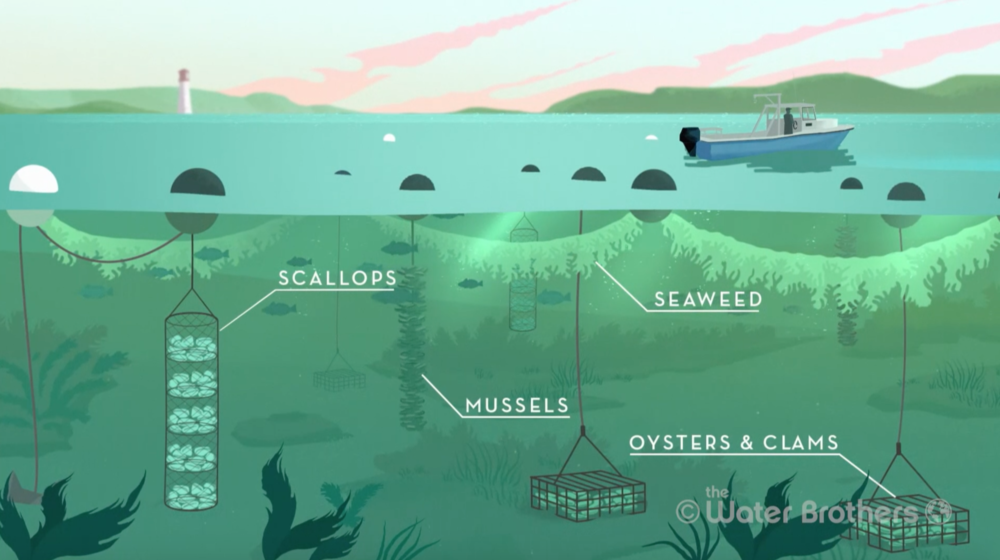By Francesca Gugino
In the light of new documentaries, such as Seaspiracy, the public has been able to see the problems with commercial fishing and aquaculture in their current forms. Both have their own set of environmental consequences that contribute to biodiversity loss, pollution, and environmental degradation. Gear from commercial fishing and toxic waters in aquaculture, among a handful of other problems, express that commercial fishing and aquaculture often do more harm than good. Seaspiracy makes several claims that protecting our oceans means no longer consuming fish, pushing the idea that veganism is the key to the climate crisis; however, more than a third of the global population relies on seafood as their primary source of protein. So it seems important that we focus on how to scale up sustainable seafood production, rather than completely change our global diets. The documentary doesn’t take into consideration the importance of sea vegetables for carbon sequestration and the role of shellfish as ‘filter feeders’ that remove excess nitrogen from the ocean. It also doesn’t explore restorative or regenerative ocean farming, leaving viewers with a sense of hopelessness. But there is hope, and it is in the scaling up of regenerative ocean farming.
Commercial fishing has contributed to 80% of all fish stocks being fully exploited or over exploited, resulting in species loss and degradation of marine ecosystems. In addition to destroying fish stocks, bycatch creates further issues, as species are unintentionally caught in nets and killed. The United Nations Environment Program (UNEP) and Food and Agriculture Organization (FAO) estimate that 640,000 tons of fishing gear are discarded into our oceans each year. Discarded fishing gear lead not only to ocean pollution, but also lead to the death of marine life. These ‘ghost nets’ entangle marine life and damage coral reefs by blocking sunlight, spreading diseases, and breaking down coral as the nets are swept across the ocean floors. Ghost nets contribute to 46% of the Great Pacific Garbage Patch (GPGP) and there is essentially no consequences for dumping as fishing gear is not traceable (World Wildlife Fund, 2021). The GPGP accounts for nearly 80,000 tons of plastic and spans across roughly 1.6 million square kilometers (National Geographic).

Globally, people consume and average of 22 kilograms of seafood per year, totaling roughly 144 million tons of seafood (European Commission, 2021). To meet global seafood demands aquaculture was upscaled, particularly fish farming. According to a recent study 50% of all fish consumed is a product of aquaculture. Although has sold itself as a sustainable way to produce fish, as it evades bycatch and doesn’t directly result in overfishing, many issues still exist. The issues that exist within current aquaculture systems include: fish feeds which are a product of overfishing, toxic water contributing to pollution, spread of diseases from farmed fish to wild fish populations, the use of antibiotics, pesticides and other chemicals, and degradation of natural habitats for the construction of fish farms. The Ted Ed video gives insight into the current problems of commercial fishing and aquaculture and proposes regenerative ocean farming as a solution.
Regenerative ocean farming utilizes both sea vegetables and shellfish to cultivate responsibly sourced seafood for local markets, while also cleaning our oceans. Recently, I have read the work Eat Like A Fish by Bren Smith, a commercial fisherman turned regenerative ocean farmer who tells his stories of time spent in the commercial fishing industry and why he has changed pathways. Smith conveys that regenerative ocean farming is not only the solution to food security and environmental and human health concerns, but that it is still an exciting and meaningful way for an ocean lover to interact with the sea. He notes that although the initial investment may be expensive for some, ranging anywhere from $5,000 to $20,000 plus a boat, there are no inputs needed in this ocean farming system. According to the Ted Ed video on regenerative ocean farming, 4,000 square meters of ocean farm can produce 25 tons of seaweed and 250,000 shellfish. Smith, who coined the term regenerative ocean farming, has worked with chefs to create incredible and unique dishes using shellfish and sea vegetables from his 20 acre ocean farm.
A similar story to Smith, Dune Lankard – an indigenous Alaskan fisherman- has also taken up regenerative ocean farming to mitigate against climate change that Alaskan natives are experiencing. Lankard now produces seaweed almost exclusively (Vittek, 2021). Below is a diagram that highlights the layout of a the regenerative ocean farm concept.

This year I have taken a serious interest in regenerative ocean farming and sustainable aquaculture, perhaps because I am living in Salthill and the ocean is at my doorstep. For years I believed that veganism was the answer to the world’s climate crisis and food security issues; but now I think differently. There is a way to create sustainable seafood that improves ocean health. And I want to continue to work toward more innovation in this specialized field, which is why I will be taking up a course at St. Andrew’s University in Sustainable Aquaculture.